Rabia Khan[i]
DOI: 10.36283/pjr.zu.11.2/004
ABSTRACT
Background and Aim: Human illness treated electrically in old concepts back in 2500 BC, electric fish used by ancient Egyptian to manage pain through “Shock”. Electro medical devices gained popularity in 19th century. TENS was developed by Melzack & Wall for pain management which in turn found to be a big invention to the field of medicine. For pain relieve TENS is considered as low budget, easy to used and non-invasive electrotherapeutical equipment around the world. Study was aimed to evaluate the approach of TENS for pain management by physical therapist.
Methodology: This cross-sectional study conducted through survey among physiotherapist of Karachi. A total No of 101 physiotherapists recruited in this study. A Self-administrated Questionnaire given to each participant for the evaluation of effectiveness of TENS for pain control. SPSS version 23.0 used for analysis.
Results: Almost 90% physiotherapist recommends TENS with other modalities. This indicates high prevalence of TENS as main modality for the management of pain by majority of the participants either solely or in combination with other modalities.
Conclusion: TENS found to have a significant effect in managing pain. Type and electrode placement also found important role in reducing pain.
Keywords: TENS, analgesic effect, neurogenic pain, gynecological condition, musculoskeletal pain, labor.
Introduction
Transcutaneous Electrical Nerve Stimulation (TENS) is a device that conveys beat electrical flow across surface of skin to stimulate nerve. A standard TENS device is comprised of a battery controlled compact machine that produces electrical flow, which conveyed through skin by the means of electrodes1.
Transcutaneous electrical nerve incitement (TENS) is an economical, self-controlled procedure with no known potential for overdose. TENS is utilized as an independent treatment for gentle to direct pain and as a subordinate to pharmacotherapy for moderate to serious pain. TENS specifically stimulates low-threshold peripheral afferents (A-β) which represses progressing nociceptive transmission in the focal sensory system2
TENS is a protected helpful device with few or no related side effects. Numerous clinical papers had published the beneficial outcomes of TENS in the management of pain. Diverse frequencies can be applied in TENS, varying from low (< 10 Hz) to high (> 50 Hz). Different frequencies can be applied in TENS, ranging from low (< 10 Hz) to high (> 50 Hz). Alone superficial sensation can be achieved by applying TENS at low intensity, to initiates muscular contraction (motor response) high intensity can be applied. Both motor and sensory response can be gained combined by using high intensity TENS3.
To strengthen physical performance, management of pain and post-operatively respiratory endurance TENS has been used. Clinical application recommended that muscles stimulation drives straight forwardly to absence of pain and diminished muscle soreness which in result restores muscular capacity. For the treatment of pain TENS considered as non-opiod equipment.
Patients having knee osteoarthritis had treated with TENS which potentially reduced pain and increased functional capability4.
Pain has been perceived to be the most widely recognized side effect for which medical services is looked for Persistent nonmalignant pain is normal among more aged people, with proof supporting an age-related expansion in the prevalence of pain5. For over 20 years, the expert writing has proposed or suggested the utilization of transcutaneous electrical nerve stimulation (TENS) as an intervention for constant pain in elderly Clinical practice rules for the administration of chronic (ie, persistent) pain in more aged people, distributed by the American Geriatrics Society, note that non-pharmacological mediations including TENS might work alone or in blend with suitable pharmacological methodologies6. TENS was considered as an alternative therapy in varicose vein patients. Not only in musculoskeletal or neurogenic pain. TENS can be used during labor7.
The study was aimed to discover the awareness, awareness, and attitude towards the treatment of pain through TENS by physical therapists. This study will be helpful to find out the cause behind the increasing preference of TENS for the pain management in different pathological conditions despite of the different manual techniques in physical therapy profession. Transcutaneous electrical nerve stimulation (TENS) can be considered as non-pharmacological option to manage pain. For different painful conditions TENS has been used. Clinical and basic knowledge related to TENS can be updated through this study8, 9.
Methodology
Study Design
We conducted a cross-sectional, survey among Physiotherapist of Karachi involved in the management of patients with different sites pain.
Sample Size
Using non-probability convenient sampling technique 101 Physiotherapist recruited in the study.
Sample Technique
Non- probability purposive sample
Data Collection
Data was collected by self-administered questionnaire containing questions regarding transcutaneous electrical nerve stimulation effects on pain. Professional physical therapist working in different clinical setups were requested to fill the questionnaire from different tertiary care hospitals including Liaquat National School of Physiotherapy, Baqai Institute of Physical Therapy & Rehabilitation Medicine, The Aga Khan University Hospital, Zia Uddin Hospital, Jinnah Post Graduate Medical Centre, SIUT and PNS Shifa.
Questionnaires were given by hand to each participant. Total time estimate for questionnaire was 10 minutes approximately.
Time Duration
This study was conducted within four months (from November 2018 to February 2019)
Inclusion Criteria
Qualified physical therapy professionals
Both Males & Female
Serving in different physical therapy clinical setups
Exclusion Criteria
Undergraduate students.
Internees.
Only Academic physical therapy professionals
Not willing to participate
Data Analysis
SPSS version 23.0 was used for analysis of data. Frequencies and percentages were calculated for categorical variables. Mean age was also reported. To see the significance between TENS and other parameters Chi-Square test was applied.
Ethical Concerns
Ethical standards as per approved by institutional research committee kept in consideration to perform this study. Informed written consent was given by all participants who participated in this study.
Results
Normality of data was checked before analysis. The Cronbach’s alpha found to be 0.982. Nine-point nine percent (n=10) used solely TENS as treatment option for pain management after TENS, 2.0% (n=2) participants used interferential therapy merely as option for pain management, 1.0% (n=1) used ultrasound as a treatment choice for pain control, 1.0% (n=1) contributors choses cryotherapy as pain control parameter. Majority 15.8% (n=16) were selected combination of different modalities as a pain control parameter including cryotherapy, ultrasound, Short wave diathermy(SWD), hot pack and TENS, 13.9% (n=14) second most commonly used combined options for pain management including cryotherapy, ultrasound, hot pack and TENS, 6.9% (n=7) used hot pack and TENS for pain control, 4.0% (n=4) contributors prefer cryotherapy, infrared, short wave diathermy(SWD),hot pack, acupuncture and TENS for the management of pain, 11.9% (n=12) participants used cryotherapy, ultrasound and TENS for pain control, 6.9% (n=7) used interferential therapy, hot pack and TENS for pain management, 5.9% (n=6) contributors used cryotherapy, ultrasound and hot pack for pain management, 7.9% (n=8) used iontophoresis and TENS in combination for pain control, 5.9% (n=6) participants prefer combine therapy for control of pain including ultrasound and TENS, 2.0% (n=2) focused on cryotherapy, ultrasound and iontophoresis for pain management and 5.0% (n=5) participants rely on infrared and TENS for the pain control.
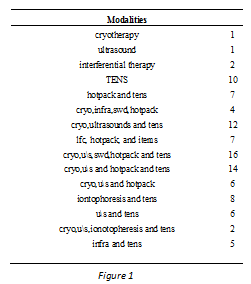
Figure 1
On the basis of TENS parameters 11.9% (n=12) contributors used only variable parameters, 22.8% (n=23) contributors used fixed parameters and majority of the contributors 65.3% (n=66) prefer variable and fixed both parameters in TENS for pain management.
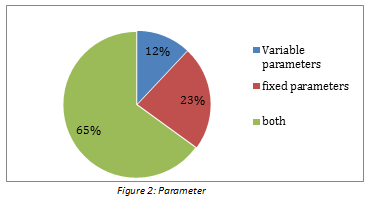
Different electrodes of TENS were used by all individuals for pain management. Majority 54.5% (n=55) used more than one type of electrode including carbon rubber electrodes with gel, carbon rubber electrodes with gel pads and self-adhesive electrodes for pain control, 20.8% (n=21) participants prefer carbon rubber electrodes with gel pads for management of pain, 16.8% (n=17) participants prefer self-adhesive electrodes for the management of pain and 7.9% (n=8) participants prefer carbon rubber electrodes for the management of pain.
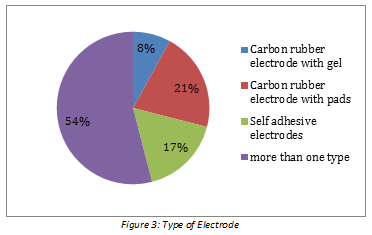
The selection of electrode was based upon different factors. Majority 26.7% (n=27) of the participants used electrode type suggested by departmental policy, 16.8% (n=17) participants select electrode type on availability, 15.8% (n=16) participants chose electrode on two factors including effectiveness and availability, 14.9% (n=15) participants prefer electrode type on effectiveness for pain management, 13.9% (n=14) participants prefer electrodes type on availability and economical basis for pain management.6.9% (n=7) participants select electrodes type on availability and departmental policy and 5.0% (n=5) participants select electrodes type economically.
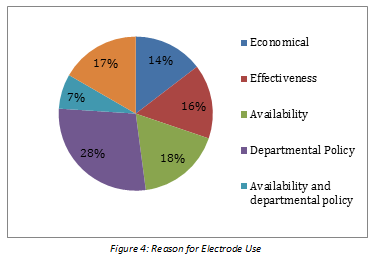
Including site of pain, peripheral nerve, spinal nerve root and acupuncture points, 13.9% (n=14) individuals applied electrodes at two different points including site of pain and spinal nerve root for pain management, 9.9% (n=10) participants applied electrodes at two different locations that is site of pain and peripheral nerve point, 8.9% (n=9) contributors applied electrodes at three different locations including site of pain, peripheral nerve and spinal nerve root, 5.0% (n=5) applied electrodes at only spinal nerve root representing area of pain location for pain management, 4.0% (n=4) contributors applied electrodes at peripheral nerve supply area for pain management and 3.0% (n=3) contributors applied electrodes at three different locations for pain management including acupuncture point, peripheral nerve and spinal nerve root.
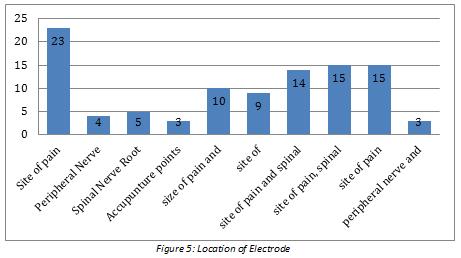
On the basis of Likert Scale 60.4% ( n=61) physiotherapist were satisfied with the application of TENS for pain management, while 22.8% (n=23) physiotherapist were strongly satisfied with use of TENS for pain control and 16.8% (n=17) physiotherapist reported neutral gesture (no benefit, no harm) for the use of TENS for pain management.
Along with TENS other modalities also used by participants for pain management. Majority contributors 73.3% (n=74)were satisfied with the use of hot pack for pain control, 46.5% (n=47) participants were strongly satisfied with the use of Cryotherapy for pain control, 46.5% (n=47) were strongly satisfied with the use of ultrasound for pain management, 42.6% (n=43) were satisfied with the application of infra-red rays for eradication of pain, 51.5% (n=52) individuals satisfied with the use of interferential therapy for pain control,44.6% (n=45) were also satisfied with the application of short wave diathermy for the management of pain, 11.9% (n=12) satisfied with the use of laser for pain control, 19.8% (n=120) participants were satisfied with the use of iontophoresis for pain management and 44.6%( 45) contributors were had neutral point of view about the use of acupuncture point for the management of pain.
TENS widely used in musculoskeletal conditions 96% (n=97) by majority of participants for pain control, along with musculoskeletal conditions 77.2% (n=78) participants used TENS for pain caused by neurogenic origins and 34.7% (n=35) contributors applied TENS in gynecological conditions. Efficacy of the TENS was compared with the other physical therapy modalities. Cross tab shows that there is significant difference of efficacy of TENS in comparison with Ultrasound with P-value 0.04 Cross tabs shows there is no significant difference of TENS in comparison with Cryotherapy for pain management with P-Value 0.155.
Comparison of TENS with Hot pack gives P-value of 0.246 on crosstab, which shows there is no significant difference. TENS is not significantly different with laser for pain management as a result shows in cross tab with P-value of 0.566
No significant difference was noted between TENS and Interferential therapy as their P-value was 0.84. There is no impact of TENS in comparison with Iontoperesis as the P.value 0.07 was insignificant.
Outcome Measures
There were no significance difference found between TENS and other modalities for pain management.
Discussion
The aim of the study is to explore the effectiveness, awareness, knowledge and attitude towards the use of TENS for pain management in professional physical therapists10.
Result shows that 83% of participants are aware with the significance use of TENS for pain management, while Licia Santos Sanata et al reported the significance of TENS used in their study which shows that the health professionals are strongly satisfied with the use of TENS (0.05) with confidence interval of 95%11. 34.7% of therapist applied TENS for the gynaecological conditions including primary dysmenorrhea, like wise Arik MI et al concluded in her meta-analysis that TENS can be used for the treatment of primary dysmenorrhea. Yilmaz M. et al stated in his study that there is no superiority between TENS & ultrasound for the selection of pain management, unlike result was concluded in our study that there is significant difference of efficacy of TENS in comparison with Ultrasound with P.value 0.04 for the pain management selection12, 13, 14.
In this study we concluded that TENS is not significantly different with laser for pain management as a result shows in cross tab with P-value of 0.56615, however M Venosa et.al concluded in their study that high intensity laser had significant difference in comparison with TENS and ultrasound. In present study a TENS and Interferential Current had no significant difference in management of pain, similar results were reported by Camilia Cadena de Almedia and Dias V et al with no significant difference16. Fahimeh kemali, et al reported in their study that application of TENS electrode at acupuncture points gives significant relief in pain, although in this study health professionals did not report the effectiveness of TENS on acupuncture point for pain relief17,18.
Sevtap Gunay Ucurum et al reported in study that there is no significance difference between the application of TENS and Ultrasound for pain management, however in this study the result was found significant for the application of TENS for pain management in comparison with Ultrasound. A Y M Jones et al, stated that there is no significance difference in pain relief when comparing the positions of electrode at different level, same results were found in this study that there is no significance difference when placing the TENS electrode at different points for pain management19,20,21,22.
No significant difference was noted in this study regarding comparison of TENS with iontophoresis for pain management however, Y cai et.al stated in his study that application of drugs through iontophoresis gives better pain relieve in comparison with oral drugs23, 24 25.
Conclusion
TENS found to had a significant effect in managing pain. Type and electrode placement also found important role in reducing pain. Application of TENS for the management of pain by qualified physiotherapist has been found enormous. In addition, other modalities also play important role in management of pain.
References
- Peng WW, Tang ZY, Zhang FR, Li H, Kong YZ, Iannetti GD, Hu L. Neurobiological mechanisms of TENS-induced analgesia. NeuroImage. 2019 Jul 15;195:396-408.
- Johnson, M.I. and Jones, G., 2017. Transcutaneous electrical nerve stimulation: current status of evidence.
- Peng WW, Tang ZY, Zhang FR, Li H, Kong YZ, Iannetti GD, Hu L. Neurobiological mechanisms of TENS-induced analgesia. NeuroImage. 2019 Jul 15;195:396-408.
- Teoli D, An J. Transcutaneous Electrical Nerve Stimulation. StatPearls [Internet]. 2020 Sep 13.
- Santana LS, Gallo RB, Ferreira CH, Duarte G, Quintana SM, Marcolin AC. Transcutaneous electrical nerve stimulation (TENS) reduces pain and postpones the need for pharmacological analgesia during labour: a randomised trial. J Physiother. 2016;62(1):29-34
- Pal S, Dixit R, Moe S, Godinho MA, Abas AB, Ballas SK, Ram S, Yousuf UA. Transcutaneous electrical nerve stimulation (TENS) for pain management in sickle cell disease. Cochrane Database of Systematic Reviews. 2020(3).
- Li, J., & Song, Y. (2017). Transcutaneous electrical nerve stimulation for postoperative pain control after total knee arthroplasty: A meta‐analysis of randomized controlled trials. Medicine (Baltimore), 96, e8036. https://doi.org/10.1097/md.0000000000008036
- Jahangirifard, A., Razavi, M., Ahmadi, Z. H., & Forozeshfard, M. (2018). Effect of TENS on postoperative pain and pulmonary function in patients undergoing coronary artery bypass surgery. Pain Management Nursing, 16, 30230–30232. https://doi.org/10.1016/j.pmn.2017.10.018
- Zeb A, Arsh A, Bahadur S, Ilyas SM. Effectiveness of transcutaneous electrical nerve stimulation in management of neuropathic pain in patients with post traumatic incomplete spinal cord injuries. Pakistan journal of medical sciences. 2018 Sep;34(5):1177.
- Mira TA, Giraldo PC, Yela DA, et al. Effectiveness of complementary pain treatment for women with deep endometriosis through transcutaneous electrical nerve stimulation (TENS): randomized controlled trial. Eur J Obstet Gynecol Reprod Biol. 2015;194:1
- Gozani SN. Fixed site high-frequency transcutaneous electrical nerve stimulation for treatment of chronic low back and lower extremity pain. J Pain Res. 2016;9:469-79
- Chaturvedi R, Kulandaivelan S, Malik M, Joshi S. Transcranial Direct Current Stimulation in Combination with TENS: Effectiveness on Pain and Functional Outcomes in Knee OA Patients: A Study Protocol. Indian Journal of Public Health Research & Development. 2019 Dec 1;10(12).
- Gibson W, Wand BM, Meads C, Catley MJ, O’Connell NE. Transcutaneous electrical nerve stimulation (TENS) for chronic pain‐an overview of Cochrane Reviews. Cochrane Database of Systematic Reviews. 2019(4).
- Munir H, Ali S, Siddique A, Safdar S, Waqas S, Kiani JA. EFFECT OF TRANSCUTANEOUS ELECTRICAL NERVE STIMULATION IN PAIN REDUCTION AND VENOUS BLOOD FLOW AUGMENTATION IN VARICOSE VEIN PATIENTS. Pakistan Journal of Physiology. 2021 Jun 30;17(2):31-4.
- Báez-Suárez A, Martín-Castillo E, García-Andújar J, García-Hernández JÁ, Quintana-Montesdeoca MP, Loro-Ferrer JF. Evaluation of different doses of transcutaneous nerve stimulation for pain relief during labour: a randomized controlled trial. Trials. 2018 Dec;19(1):1-0.
- Santana LS, Gallo RB, Ferreira CH, Duarte G, Quintana SM, Marcolin AC. Transcutaneous electrical nerve stimulation (TENS) reduces pain and postpones the need for pharmacological analgesia during labour: a randomised trial. Journal of physiotherapy. 2016 Jan 1;62(1):29-34.
- Arik MI, Kiloatar H, Aslan B, Icelli M. The effect of tens for pain relief in women with primary dysmenorrhea: A systematic review and meta-analysis. EXPLORE. 2020 Aug 29:2541.
- Yilmaz M, Tarakci D, Tarakci E. Comparison of high-intensity laser therapy and combination of ultrasound treatment and transcutaneous nerve stimulation on cervical pain associated with cervical disc herniation: A randomized trial. Complementary therapies in medicine. 2020 Mar 1;49:102295.
- Venosa M, Romanini E, Padua R, Cerciello S. Comparison of high-intensity laser therapy and combination of ultrasound treatment and transcutaneous nerve stimulation in patients with cervical spondylosis: a randomized controlled trial. Lasers in medical science. 2019 Jul;34(5):947-53.
- de Almeida CC, da Silva VZ, Júnior GC, Liebano RE, Durigan JL. Transcutaneous electrical nerve stimulation and interferential current demonstrate similar effects in relieving acute and chronic pain: a systematic review with meta-analysis. Brazilian journal of physical therapy. 2018 Sep 1;22(5):347-54.
- Dias LV, Cordeiro MA, de Sales RS, dos Santos MM, Korelo RI, Vojciechowski AS. Immediate analgesic effect of transcutaneous electrical nerve stimulation (TENS) and interferential current (IFC) on chronic low back pain: Randomised placebo-controlled trial. Journal of Bodywork and Movement Therapies. 2021 Jul 1;27:181-90.
- Kamali F, Mirkhani H, Nematollahi A, Heidari S, Moosavi E, Mohamadi M. The effect of transcutaneous electrical nerve stimulation of sympathetic ganglions and acupuncture points on distal blood flow. Journal of acupuncture and meridian studies. 2017 Apr 1;10(2):120-4.
- Ucurum SG, Kaya DO, Kayali Y, Askin A, Tekindal MA. Comparison of different electrotherapy methods and exercise therapy in shoulder impingement syndrome: A prospective randomized controlled trial. Acta orthopaedica et traumatologica turcica. 2018 Jul 1;52(4):249-55.
- Eksakulkla S, Surapat C, Patsonwutthiload P, Kanjanakul S. The comparative effect of two types of electrode placement for acupuncture-like TENS on pain relief in patients with chronic neck pain. 2018 Sep 25;40(3):104-19.
- Cai Y, Zhou Y, Zhang P, Kalia YN, Gratieri T, Chen Y. Tissue Levels of Flurbiprofen in the Rat Plantar Heel after Short-Duration Topical Iontophoresis Are Sufficient to Induce Pharmacodynamic Responses to Local Pain Stimuli. Pharmaceutics. 2020 Jul;12(7):608.
The Ziauddin University is on the list of I4OA (https://i4oa.org/) & I4OC (https://i4oc.org/).
![]() This is an open-access article distributed under the terms of the Creative Commons Attribution License (CC BY 4.0). https://creativecommons.org/licenses/by/4.0/
This is an open-access article distributed under the terms of the Creative Commons Attribution License (CC BY 4.0). https://creativecommons.org/licenses/by/4.0/
Conflict of Interest: The author (s) have no conflict.
[i] BSPT, DPT-D, M.Sc. (PT) Senior Lecturer, Bahria University College of Physical Therapy, Bahria University Medical & Dental College.
ORCID ID: 0000-0003-4669-2121
